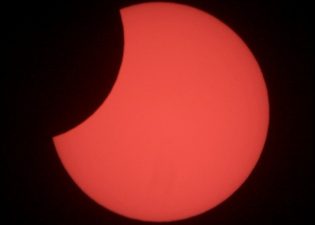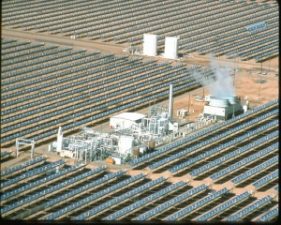BrightSource Energy is making a big bet on CSP while others switch to PV
The third huge US solar project from BrightSource Energy is its largest yet. At a whopping 750 MW it is the size of three or four US coal or gas plants.
Its Rio Mesa Solar Electric Generating Facility in California will use the solar tower technology it inherited from Israel’s Luz, its parent company (Luz Rises Again as BrightSource for California) in which a field of mirrors on poles reflects sunlight onto a tower to create steam to drive a turbine to make electricity.
But it comes at a time when many utility-scale solar companies are switching to PV (photovoltaic) solar – those traditional rooftop solar panels that most people associate with solar – from Concentrated Solar Power (CSP) such as this. Why?
BrightSource Energy is betting on the steam-producing type of mirror-reflecting solar. After all, its precursor, Luz Energy, is the company that wrote the book on non-PV solar. Luz built the world’s only decades-long test case for utility-scale solar in the 1980’s under former president Jimmy Carter‘s push for renewable energy development that was cut short before any other solar companies got into the act.
But PV solar has yielded staggering price drops through Chinese mass production driven by the massive growth of rooftop installs in the EU, resulting from climate policy there. The ensuing fast-dropping costs prompted utility-scale project developers to reassess the financial benefits of PV. Some of the Recovery Act funded projects have switched to PV even if it meant forgoing funding support from the US government by making the switch, in an indication of just how competitive the new PV prices are.
In the Southwest US, eight utility-scale solar projects, even with approved plans have switched from CSP or solar thermal with mirrored troughs to PV since the price drops, which have amounted to 50% off over the last two years.
But CSP has advantages over PV at utility-scale: land use and water conservation, and the potential to add storage for night time solar.
BrightSource’s Rio Mesa plant would use 33% less land than comparable megawatts of PV (or a solar thermal plant with long mirrored troughs). And by using air cooling to turn steam back into water, the BrightSource plant’s water use will be less than a tenth of that of competing technologies. And of course, CSP can easily store nearly 100% of its energy in molten salts, to release the heat later for night time solar electricity.
While mass-production (driven by policies, which drive demand) will always reduce the price of any given novel technology, there is no reason that CSP prices wouldn’t also drop with mass production too, just as PV prices did. We just don’t know which solar technology will be the winner in the end. (Which Solar Technologies Will Have the Most Investment Appeal?)
But, as the US heads into a second valley of death, following the brief flowering of progressive policies on renewable energy under Obama, just like Luz did before it after the first valley of death following Carter’s support for solar, BrightSource may well have bet on the solar technology with staying power.
Related stories:
BrightSource Gets a Billion
BrightSource Teams up with Bectel to Build Large California Solar
BrightSource Prepares for NASDAQ IPO




